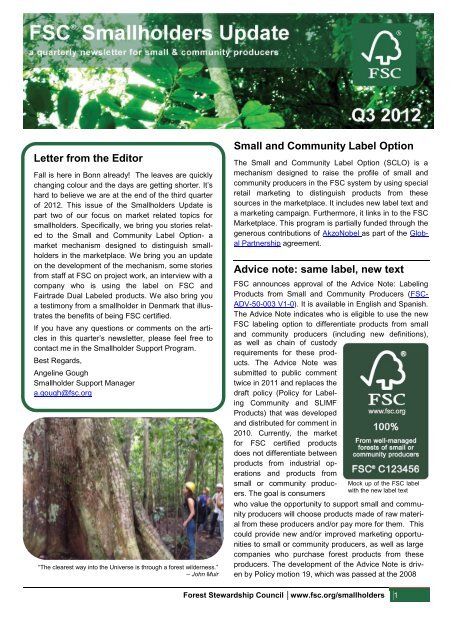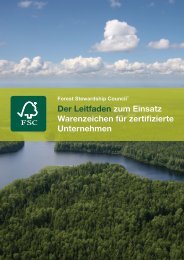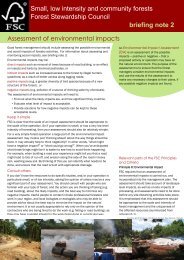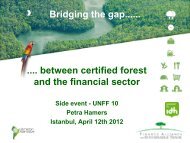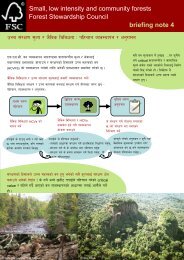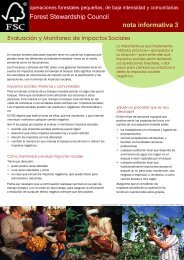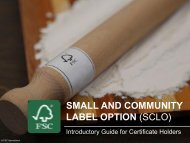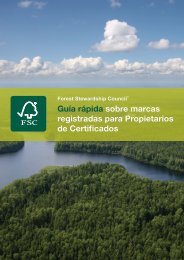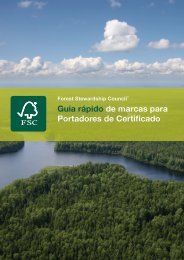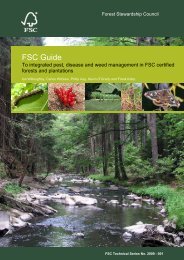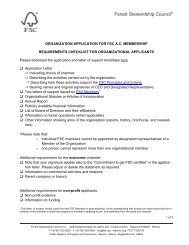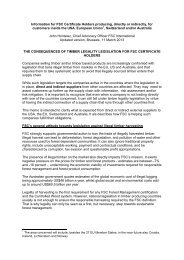Letter from the Editor Small and Community Label Option Advice note
Letter from the Editor Small and Community Label Option Advice note
Letter from the Editor Small and Community Label Option Advice note
You also want an ePaper? Increase the reach of your titles
YUMPU automatically turns print PDFs into web optimized ePapers that Google loves.
<strong>Letter</strong> <strong>from</strong> <strong>the</strong> <strong>Editor</strong><br />
Fall is here in Bonn already! The leaves are quickly<br />
changing colour <strong>and</strong> <strong>the</strong> days are getting shorter. It’s<br />
hard to believe we are at <strong>the</strong> end of <strong>the</strong> third quarter<br />
of 2012. This issue of <strong>the</strong> <strong>Small</strong>holders Update is<br />
part two of our focus on market related topics for<br />
smallholders. Specifically, we bring you stories related<br />
to <strong>the</strong> <strong>Small</strong> <strong>and</strong> <strong>Community</strong> <strong>Label</strong> <strong>Option</strong>- a<br />
market mechanism designed to distinguish smallholders<br />
in <strong>the</strong> marketplace. We bring you an update<br />
on <strong>the</strong> development of <strong>the</strong> mechanism, some stories<br />
<strong>from</strong> staff at FSC on project work, an interview with a<br />
company who is using <strong>the</strong> label on FSC <strong>and</strong><br />
Fairtrade Dual <strong>Label</strong>ed products. We also bring you<br />
a testimony <strong>from</strong> a smallholder in Denmark that illustrates<br />
<strong>the</strong> benefits of being FSC certified.<br />
If you have any questions or comments on <strong>the</strong> articles<br />
in this quarter’s newsletter, please feel free to<br />
contact me in <strong>the</strong> <strong>Small</strong>holder Support Program.<br />
Best Regards,<br />
Angeline Gough<br />
<strong>Small</strong>holder Support Manager<br />
a.gough@fsc.org<br />
“The clearest way into <strong>the</strong> Universe is through a forest wilderness.”<br />
– John Muir<br />
<strong>Small</strong> <strong>and</strong> <strong>Community</strong> <strong>Label</strong> <strong>Option</strong><br />
The <strong>Small</strong> <strong>and</strong> <strong>Community</strong> <strong>Label</strong> <strong>Option</strong> (SCLO) is a<br />
mechanism designed to raise <strong>the</strong> profile of small <strong>and</strong><br />
community producers in <strong>the</strong> FSC system by using special<br />
retail marketing to distinguish products <strong>from</strong> <strong>the</strong>se<br />
sources in <strong>the</strong> marketplace. It includes new label text <strong>and</strong><br />
a marketing campaign. Fur<strong>the</strong>rmore, it links in to <strong>the</strong> FSC<br />
Marketplace. This program is partially funded through <strong>the</strong><br />
generous contributions of AkzoNobel as part of <strong>the</strong> Global<br />
Partnership agreement.<br />
<strong>Advice</strong> <strong>note</strong>: same label, new text<br />
FSC announces approval of <strong>the</strong> <strong>Advice</strong> Note: <strong>Label</strong>ing<br />
Products <strong>from</strong> <strong>Small</strong> <strong>and</strong> <strong>Community</strong> Producers (FSC-<br />
ADV-50-003 V1-0). It is available in English <strong>and</strong> Spanish.<br />
The <strong>Advice</strong> Note indicates who is eligible to use <strong>the</strong> new<br />
FSC labeling option to differentiate products <strong>from</strong> small<br />
<strong>and</strong> community producers (including new definitions),<br />
as well as chain of custody<br />
requirements for <strong>the</strong>se products.<br />
The <strong>Advice</strong> Note was<br />
submitted to public comment<br />
twice in 2011 <strong>and</strong> replaces <strong>the</strong><br />
draft policy (Policy for <strong>Label</strong>ing<br />
<strong>Community</strong> <strong>and</strong> SLIMF<br />
Products) that was developed<br />
<strong>and</strong> distributed for comment in<br />
2010. Currently, <strong>the</strong> market<br />
for FSC certified products<br />
does not differentiate between<br />
products <strong>from</strong> industrial operations<br />
<strong>and</strong> products <strong>from</strong><br />
small or community producers.<br />
The goal is consumers<br />
Mock up of <strong>the</strong> FSC label<br />
with <strong>the</strong> new label text<br />
who value <strong>the</strong> opportunity to support small <strong>and</strong> community<br />
producers will choose products made of raw material<br />
<strong>from</strong> <strong>the</strong>se producers <strong>and</strong>/or pay more for <strong>the</strong>m. This<br />
could provide new <strong>and</strong>/or improved marketing opportunities<br />
to small or community producers, as well as large<br />
companies who purchase forest products <strong>from</strong> 1 <strong>the</strong>se<br />
producers. The development of <strong>the</strong> <strong>Advice</strong> Note is driven<br />
by Policy motion 19, which was passed at <strong>the</strong> 2008<br />
Forest Stewardship Council │www.fsc.org/smallholders 1
SCLO advice <strong>note</strong> continued…<br />
FSC General Assembly. The new labeling option is available<br />
for products <strong>from</strong> small <strong>and</strong> community producers all<br />
over <strong>the</strong> globe. The first products to use <strong>the</strong> new labeling<br />
option are those <strong>from</strong> <strong>the</strong> FSC <strong>and</strong> Fairtrade Dual Certification<br />
pilot project.<br />
________________________________<br />
<strong>Small</strong> <strong>and</strong> community producers use<br />
storytelling to find <strong>the</strong>ir market niche<br />
By Liz Dimmlich, Br<strong>and</strong> Manager<br />
FSC is currently developing a marketing campaign to distinguish<br />
FSC’s <strong>Small</strong> <strong>and</strong> <strong>Community</strong> <strong>Label</strong> <strong>Option</strong><br />
(SCLO) in <strong>the</strong> marketplace.<br />
The key marketing challenge for any br<strong>and</strong> is to inspire<br />
consumers to purchase your products, <strong>the</strong>reby distinguishing<br />
yourself in <strong>the</strong> market. But how do you grab <strong>the</strong><br />
attention of time-poor consumers <strong>and</strong> shift <strong>the</strong>ir shopping<br />
behaviour in a meaningful way By telling stories.<br />
The core of <strong>the</strong> SCLO campaign will be an online toolkit<br />
enabling retailers to create marketing materials featuring<br />
FSC certified products <strong>from</strong> smallholders. Telling <strong>the</strong>se<br />
stories of connection between producers <strong>and</strong> consumers<br />
can create a powerful “people to people” bond, <strong>and</strong> ultimately<br />
drive purchase preference for FSC products. The<br />
campaign aims to send <strong>the</strong> message that by choosing<br />
FSC, <strong>the</strong> consumer is actively supporting responsible<br />
forest management <strong>and</strong> <strong>the</strong> livelihoods of small <strong>and</strong><br />
community-based forest enterprises around <strong>the</strong> world.<br />
The FSC st<strong>and</strong>ard is an important marketing tool for timber<br />
traders, retailers, <strong>and</strong> specialist niche markets, with<br />
Photo courtesy of Angeline Gough<br />
customer awareness in retail Photo courtesy <strong>and</strong> of niche Angeline Gough markets on an<br />
upward trend. A study conducted in 2008 revealed that a<br />
strong br<strong>and</strong> is <strong>the</strong> best way to overcome price competition,<br />
especially in niche markets where customer dem<strong>and</strong><br />
for ethically <strong>and</strong> sustainably sourced wood products is<br />
highest <strong>and</strong> consumers are willing to pay more for products<br />
that tell a story about where <strong>the</strong> timber is <strong>from</strong> <strong>and</strong><br />
under what conditions it is produced. Often, small <strong>and</strong><br />
community producers have such stories but smaller volumes<br />
<strong>and</strong> less contact with <strong>the</strong> end-market mean that<br />
<strong>the</strong>se producers are not likely to find opportunities to<br />
promote <strong>the</strong>mselves to consumers.<br />
The FSC has outlined eligibility requirements for who can<br />
use <strong>the</strong> small <strong>and</strong> community label option. Currently, all<br />
small <strong>and</strong> low-intensity managed forests (SLIMF) are eligible,<br />
as well as communities that identify as indigenous<br />
or traditional. This means that indigenous forest-based<br />
communities <strong>from</strong> Brazil to <strong>the</strong> Boreal can bring <strong>the</strong>ir<br />
unique story to <strong>the</strong> sale of <strong>the</strong>ir forest products. In<br />
addition, small local producers <strong>and</strong> mills could team up<br />
with a niche retailer to tell a ‘locally-made’ story, while<br />
community cooperatives could tell of <strong>the</strong> positive impacts<br />
of <strong>the</strong>ir responsible forest management on <strong>the</strong><br />
well-being of <strong>the</strong>mselves <strong>and</strong> <strong>the</strong>ir environment.<br />
Initial benefits of <strong>the</strong> campaign to smallholders include<br />
improved market penetration <strong>and</strong> visibility. Currently in<br />
development, <strong>the</strong> campaign will be finalized in late 2012<br />
ahead of an official launch in <strong>the</strong> spring of 2013. Campaign<br />
enquiries can be directed to Liz Dimmlich, Br<strong>and</strong><br />
Manager (L.Dimmlich@fsc.org).<br />
FSC Marketplace – an Opportunity<br />
for <strong>Small</strong>holders<br />
By Alina Paetz, Key Accounts Officer<br />
The FSC Marketplace is an international online platform<br />
that aims to bring buyers <strong>and</strong> sellers of FSC certified<br />
products in <strong>the</strong> FSC supply chain toge<strong>the</strong>r – <strong>and</strong> it provides<br />
a valuable opportunity for smallholders around <strong>the</strong><br />
world. After having been tested as a pilot in a number of<br />
countries, <strong>the</strong> FSC Marketplace beta site is now under<br />
fur<strong>the</strong>r development. It is expected to roll-out worldwide<br />
towards <strong>the</strong> end of 2012. The beta site is online here:<br />
www.marketplace.fsc.org . We invite you to have a look<br />
<strong>and</strong> see how <strong>the</strong> FSC Marketplace can contribute to<br />
your business. We will keep you updated on developments<br />
around <strong>the</strong> FSC Marketplace through this newsletter.<br />
Easy to create a profile<br />
Buyers around <strong>the</strong> world will be able to identify FSC<br />
certified smallholders <strong>and</strong> explore <strong>the</strong>ir product range<br />
<strong>and</strong> assortment. All smallholders have to do is fill out<br />
<strong>the</strong>ir free profile online, <strong>and</strong> <strong>the</strong>y will show up when<br />
buyers search for FSC certified products.<br />
<strong>Small</strong> or <strong>Community</strong> <strong>Label</strong> <strong>Option</strong> as a product attribute<br />
It will be possible for users of <strong>the</strong> FSC Marketplace to<br />
search <strong>the</strong> site for smallholders who are eligible to use<br />
<strong>the</strong> <strong>Small</strong> <strong>and</strong> <strong>Community</strong> <strong>Label</strong> <strong>Option</strong>. Eligibility for<br />
<strong>the</strong> label option is determined by certification bodies<br />
<strong>and</strong> indicated in <strong>the</strong> profile of <strong>the</strong> certificate holder.<br />
Since <strong>the</strong> <strong>Small</strong> <strong>and</strong> <strong>Community</strong> <strong>Label</strong> <strong>Option</strong> is also a<br />
marketing campaign that retailers can use to distinguish<br />
FSC products in <strong>the</strong>ir stores, <strong>the</strong>re is a lot of interest in<br />
linking small producers to new supply chains. The FSC<br />
Marketplace will play a key role in building better business<br />
relationships, so it is important to ensure that 2 as a<br />
smallholder, you complete a profile on <strong>the</strong> site.<br />
Forest Stewardship Council │www.fsc.org/smallholders 2
<strong>Small</strong>holder spotlight: SSC Forestry<br />
FSC <strong>and</strong> Fairtrade ® Certification as a<br />
Market Opportunity<br />
Interview with Klas Bengtsson, Managing Director at SSC<br />
Forestry<br />
SSC Forestry has been active in <strong>the</strong> field of sustainable<br />
forestry, forest certification <strong>and</strong> natural resource management<br />
for more than 15 years. The company has firsth<strong>and</strong><br />
experiences of developing umbrella certification of small<br />
l<strong>and</strong>holders according to FSC SLIMF <strong>and</strong> also a comprehensive<br />
experience in developing small/medium scale export<br />
oriented wood industries. Based on this <strong>and</strong> <strong>the</strong> fact<br />
that <strong>the</strong> company owns a small sawmill in Curacautin, central<br />
south of Chile, SSC Forestry was asked by FSC <strong>and</strong><br />
FLO-Fairtrade to become one of three pilot project on FSC<br />
<strong>and</strong> Fairtrade dual certification in 2010.<br />
Klas Bengtsson <strong>from</strong> SSC Forestry tells us about <strong>the</strong> decision<br />
to work with FSC <strong>and</strong> Fairtrade certification; “Almost<br />
all small sawmills <strong>and</strong> drying facilities we had seen while<br />
working in <strong>the</strong> South were more or less inefficient <strong>and</strong><br />
dangerous <strong>and</strong> <strong>the</strong>refore not relevant for profitable <strong>and</strong><br />
sustainable export. Fur<strong>the</strong>rmore, <strong>the</strong> small farmers had no<br />
access to fair paying markets <strong>and</strong> <strong>the</strong>refore were often<br />
extremely poor despite <strong>the</strong> fact <strong>the</strong>y had (potentially) valuable<br />
forests. With no relevant market, <strong>the</strong> farmers had no<br />
interests in investing in <strong>and</strong> protecting <strong>the</strong>ir forests.”<br />
To help <strong>the</strong> small farmers find benefit <strong>from</strong> responsible<br />
forestry, SSC Forestry developed <strong>the</strong> project in Curacautin<br />
<strong>and</strong> in March 2011 <strong>the</strong> world’s first FSC <strong>and</strong> Fairtrade certified<br />
sawmill was finally a fact. “We have spent major efforts<br />
on making <strong>the</strong> dream come true – to build a smallscale<br />
but competitive sawmill with <strong>the</strong> latest technology<br />
<strong>and</strong> best quality output while being affordable for local entrepreneurs.<br />
The project is based on <strong>the</strong> concept of Creating<br />
Shared Value <strong>and</strong> is carried out in close co-operation<br />
with local farmers <strong>and</strong> <strong>the</strong> Mapuche communities organized<br />
in an FSC Group SLIMF Certificate.”<br />
Klas elaborates on <strong>the</strong> benefits for smallholders; “The<br />
small forest owners <strong>and</strong> <strong>the</strong> workers are now organized in<br />
a Fairtrade Association <strong>and</strong> are receiving fair payments for<br />
<strong>the</strong>ir work as well as improved levels of health <strong>and</strong> safety<br />
protection. The local cooperative is also being provided<br />
with forest education as well as business <strong>and</strong> technical<br />
training. On top of that, <strong>the</strong> association receives <strong>the</strong><br />
Fairtrade Premium, calculated as 10% of <strong>the</strong> transparent<br />
price of <strong>the</strong> products sold by <strong>the</strong> sawmill to <strong>the</strong> Fairtrade<br />
customer. Fur<strong>the</strong>rmore, <strong>the</strong> FSC <strong>and</strong> Fairtrade certifications<br />
create access to new markets as <strong>the</strong> dual label is a<br />
unique way for communities <strong>and</strong> smallholders to differentiate<br />
<strong>the</strong>ir products.<br />
On <strong>the</strong> global market <strong>the</strong> competition is tough <strong>and</strong> this is<br />
a way to distinguish products <strong>from</strong> competitors’ products.”<br />
Klas continues: “The interest for joining <strong>the</strong> FSC Group<br />
SLIMF Certificate is bigger than <strong>the</strong> capacity <strong>and</strong> market.<br />
Production capacity in Curacautin is today 1-2 containers<br />
per months but can with some investments be<br />
increased up to 5-10 containers per month. At <strong>the</strong> moment,<br />
focus is <strong>the</strong>refore on developing <strong>the</strong> market, <strong>and</strong><br />
recently one of Europe’s biggest producers of high<br />
quality parquets, Kährs, have tested <strong>and</strong> accepted <strong>the</strong><br />
wood for <strong>the</strong> world’s first flooring made <strong>from</strong> wood that<br />
is FSC <strong>and</strong> Fairtrade certified.”<br />
Photo courtesy of Anushree Shukla<br />
According to Klas <strong>the</strong> FSC <strong>and</strong> Fairtrade dual label also<br />
holds market opportunities for companies; “FSC <strong>and</strong><br />
Fairtrade dual labeled products will attract increasing<br />
interest for environmentally conscious <strong>and</strong> socially responsible<br />
wood. By including FSC <strong>and</strong> Fairtrade dual<br />
labeled products in <strong>the</strong> collections, companies can create<br />
shared values <strong>and</strong> communicate social <strong>and</strong> environmental<br />
responsibility. Customer interests are already<br />
strongly indicated in Sweden, Norway, Engl<strong>and</strong> <strong>and</strong><br />
Germany, even though <strong>the</strong>re has been almost no marketing<br />
of FSC <strong>and</strong> Fairtrade dual labeled products yet.”<br />
Klas explains fur<strong>the</strong>r that <strong>the</strong> FSC <strong>and</strong> Fairtrade dual<br />
labeling is a very effective way to communicate, however,<br />
he is of <strong>the</strong> conviction that it should be combined<br />
with storytelling. “If <strong>the</strong> labels are combined with a story<br />
about <strong>the</strong> Curacautin community – ei<strong>the</strong>r on <strong>the</strong> product<br />
or in promotional material – <strong>the</strong> company communicates<br />
in a very effective way, which produces a real competitive<br />
advantage.”<br />
Klas finish <strong>the</strong> interview by sharing <strong>the</strong> hope for <strong>the</strong> future;<br />
“The expectation is that this unique experience will<br />
be replicated by o<strong>the</strong>rs in different places of <strong>the</strong> world to<br />
extend <strong>the</strong> benefits of dual FSC <strong>and</strong> Fairtrade certification<br />
to o<strong>the</strong>r communities.”<br />
Non-mechanized logging in Curacautin, Chile<br />
3<br />
Forest Stewardship Council │www.fsc.org/smallholders 3
<strong>Small</strong>holder Voices: Barritskov Forest, Denmark<br />
Barritskov: working with nature<br />
Testimony collected by Pernille Poulsen, FSC Denmark<br />
Barritskov Estate was <strong>the</strong> first FSC certified forest in<br />
Denmark. It was certified in 2006 with an area of 331<br />
ha, which qualifies it as a smallholder in <strong>the</strong> FSC system.<br />
Barritskov Estate has a range of FSC certified Non-<br />
Timber Forest Products (NTFPs) such as plants <strong>and</strong><br />
flowers (ramsons leaves <strong>and</strong> flowers, stinging nettles,<br />
ground elders <strong>and</strong> rosehips). They also selectively harvest<br />
timber.<br />
Why did Barritskov Estate choose to get FSC certified<br />
Barritskov Estate chose to get FSC certified because it<br />
was in line with <strong>the</strong> way <strong>the</strong>y already managed <strong>the</strong> forest.<br />
Their philosophy is that <strong>the</strong>y want to work with nature<br />
ra<strong>the</strong>r than against nature. Basically, <strong>the</strong>y think;<br />
“What does <strong>the</strong> nature already have to offer” ra<strong>the</strong>r<br />
than “What is it we want <strong>from</strong> <strong>the</strong> forest” An example is<br />
ramsons (Allium ursinum), which grow as wild monocultures.<br />
They harvest <strong>the</strong> wild ramsons instead of creating<br />
a field <strong>and</strong> cultivating it <strong>the</strong>mselves. In general, <strong>the</strong>y<br />
explore what NTFPs <strong>the</strong>y can commercialize <strong>from</strong> <strong>the</strong>ir<br />
forests. Then <strong>the</strong>y identify how to sell each product <strong>and</strong><br />
make a plan for harvesting at a sustainable level than<br />
conserves <strong>the</strong> forest ecosystem.<br />
Barritskov Estate delivers <strong>the</strong> FSC certified wood for <strong>the</strong><br />
projects <strong>and</strong> <strong>the</strong> designers transform it into beautiful furniture.<br />
In addition, Barritskov Estate find that <strong>the</strong> FSC label<br />
says a lot <strong>and</strong> that it is a good way to communicate how<br />
<strong>the</strong>y manage <strong>the</strong> forest.<br />
Harvesting ramsons in spring (photo courtesy of Barritskov Forest Estate)<br />
What does Barritskov Estate want to pass on to o<strong>the</strong>rs<br />
who want to get FSC certified<br />
Barritskov Estate thinks it has been a challenge to get FSC<br />
certified because it requires extra work <strong>and</strong> sometimes it<br />
can be complicated to underst<strong>and</strong> how to comply with <strong>the</strong><br />
st<strong>and</strong>ards. However, <strong>the</strong>ir certification body is really good<br />
at explaining everything <strong>and</strong> providing advice. Their advice<br />
to o<strong>the</strong>r smallholders is to not lose heart, just because it<br />
requires extra work <strong>the</strong> first time. With time Barritskov Estate<br />
has experienced that <strong>the</strong> FSC certification is effective<br />
in in guiding <strong>the</strong> forest operations. In <strong>the</strong> long run, <strong>the</strong> FSC<br />
certification actually makes things easier.<br />
Want to read more success stories <strong>from</strong> smallholders<br />
Forest st<strong>and</strong>s in winter (photo courtesy of Barritskov Forest Estate)<br />
Headlines of interest <strong>from</strong> fsc.org<br />
What are <strong>the</strong> benefits of <strong>the</strong> FSC certification<br />
To Barritskov Estate it is an advantage that <strong>the</strong> FSC<br />
system has rules that <strong>the</strong>y have to follow. In a busy<br />
workday everything happens fast, but with <strong>the</strong> rules, <strong>the</strong><br />
employees stop <strong>and</strong> think about where <strong>the</strong>y should pay<br />
special attention. In this way, Barritskov Estate can<br />
practice <strong>the</strong>ir ‘do no harm’ approach by following <strong>the</strong><br />
FSC Principles <strong>and</strong> Criteria. Fur<strong>the</strong>rmore, Barritskov<br />
Estate feel <strong>the</strong>re are a lot of opportunities for commercial<br />
projects when one is certified. For example, <strong>the</strong>y<br />
have been involved in a project with Danish designers<br />
who want to use FSC certified wood: “Skud på stamen<br />
2010.”<br />
<br />
<br />
<br />
<br />
<br />
<br />
New <strong>Community</strong> Agro-Forestry H<strong>and</strong>book <strong>from</strong><br />
The Forest Trust<br />
Public consultation launched on forest contractor<br />
certification<br />
FSC Denmark visiting smallholders in Tanzania<br />
Public Consultation launched on FSC <strong>Advice</strong><br />
<strong>note</strong> on Access to Information regarding Species<br />
<strong>and</strong> Origin of Timber<br />
Q&A on <strong>the</strong> EU Timber Regulations<br />
A corking idea to regenerate forests<br />
4<br />
Forest Stewardship Council │www.fsc.org/smallholders 4


